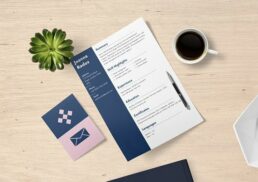Want to know how to build a resume that gets noticed? You’re in the right place. This guide on building your resume will show you the essential steps to create a resume that stands out. From compiling your work history to making it ATS-friendly, we cover everything you need to impress hiring managers and secure job interviews.
Table of Contents
Key Takeaways
A strong resume is essential in today’s competitive job market, so keep it concise, organized, and impactful while effectively showcasing your skills and experiences.
Select the right resume format—Chronological, Functional, or Combination—to best highlight your qualifications based on your career stage and goals.
Optimize your resume for Applicant Tracking Systems (ATS) by using job-specific keywords and maintaining a clean format to enhance your chances of getting noticed by hiring managers.
The Best Guide to Building Your Resume in 2024

A resume is not just a document; it’s your primary tool for securing job interviews. Think of it as your first interview, a chance to make a lasting impression on potential employers. In 2024, the job market is more competitive, and hiring managers often spend less than a minute reviewing each professional resume they receive. This makes clarity and impact crucial. A strong resume should be organized, clean, and contain valuable information about your relevant experience, skills, and achievements.
Use job-specific keywords to make your resume stand out. These keywords not only attract hiring managers but also help your resume pass through Applicant Tracking Systems (ATS). Pay attention to font styles, sizes, and spacing to enhance the resume’s overall appearance.
Keep your resume to one page to remain concise and impactful. This guide will help you gather essential information, choose the right resume format, craft a compelling headline and summary, highlight your work experience, and more.
Introduction
A good resume is your ticket to obtaining job responses and securing interviews. On the flip side, a weak resume can lead to delays in receiving job responses, dragging out your job search for weeks or even months.
This guide will help you avoid those pitfalls by showing you how to build a strong, effective resume that stands out in the competitive job market.
Collect Essential Information
Gather all essential information before starting your resume. This includes contact details, work history, education, and certifications. Having this information handy will make the resume-building process smoother and ensure you don’t miss any important details.
In the following sections, we’ll dive deeper into each of these components.
Contact Details
Your contact details are the first thing potential employers will see, so make sure they’re professional and accurate. Include your name, professional email address, phone number, and LinkedIn profile. Make sure to double-check for any typos. It’s important that your contact information is accurate.
A single error here can cost you a job opportunity, so attention to detail is paramount.
Work History
Your work history is one of the most important sections of your resume. Here’s what to include:
Previous job titles
Employers
Dates of employment
Responsibilities
Achievements
Arrange these in reverse-chronological order, starting with your most recent position.
If you have over a decade of experience, focus on the most relevant positions and achievements to keep your resume concise and impactful.
Education and Certifications
Your educational background and certifications are crucial for demonstrating your qualifications. List degrees obtained, institutions attended, and graduation dates. Also, include any relevant certifications, licenses, or training programs that enhance your qualifications for the job.
If you’re still completing your degree, provide your expected graduation date to give employers a clear timeline.
Choose the Right Resume Format
Choosing the right resume format is key to showcasing your skills and experiences effectively. The three main types are Chronological, Functional, and Combination, each suited to different career stages and goals.
The right format can significantly influence how potential employers perceive your resume.
Chronological Resume Format
The chronological resume format is ideal for individuals with a consistent work history and relevant experience. It emphasizes your work history in reverse chronological order, making it easy for employers to see your career progression.
This format is particularly effective for job seekers who have a solid track record in their field.
Functional Resume Format
The functional resume format focuses on showcasing your skills and competencies rather than your chronological work history. This format is beneficial for job seekers who have limited work experience or are changing careers. It allows you to emphasize your transferable skills and how they align with the job requirements.
Combination Resume Format
The combination resume format highlights both your skills and work history, making it a hybrid approach to resume writing. This format is suitable for experienced professionals looking to emphasize specific competencies alongside their work history.
It allows you to showcase your achievements while providing a clear timeline of your career.
Craft a Compelling Resume Headline and Summary
A compelling resume headline and summary can capture the attention of hiring managers and set you apart from other candidates. Your resume headline should reflect your job title, years of experience, and key skills or achievements.
The resume summary gives a concise overview of your career. It typically consists of two to three sentences. Customizing these elements for the specific job can significantly enhance their impact.
Resume Headline
Your resume headline is the first thing hiring managers will see, so it needs to be impactful.
Place it next to or underneath your contact information.
A good headline is:
concise
reflects your job title
includes years of experience
highlights key skills or achievements
It serves as a snapshot of your professional identity.
Resume Summary
A resume summary offers a brief glimpse into your professional journey, typically in two to three sentences. Customizing your customer service resume for the specific job increases its relevance and impact.
This section can effectively differentiate you from other candidates by showcasing your significant qualifications and experiences.
Highlight Your Work Experience
Your work experience section showcases your professional journey and achievements. Align this section with the job description to enhance your resume’s impact. Focus on relevant experiences and skills, especially if you’re applying for a job unrelated to your past experiences.
Emphasize quantifiable achievements to demonstrate your impact.
Job Titles and Responsibilities
Ensure accurate job titles in your work history section to avoid misleading potential employers. This builds trust and provides a clear view of your professional journey.
Listing your responsibilities gives hiring managers a sense of your role and contributions.
Achievements and Impact
Highlighting measurable contributions from previous roles can greatly enhance your resume’s effectiveness. These achievements demonstrate your value to potential employers and set you apart from other candidates. Examples include quantifiable sales numbers, project completion rates, and customer satisfaction scores.
Detail Your Educational Background
Your educational background is crucial, especially if relevant to the job. Only include your highest degree unless you’re a recent graduate needing to highlight more academic achievements.
List relevant training programs alongside degrees to showcase continuous professional development.
Academic Qualifications
Include all degrees earned in your resume, such as bachelor’s, master’s, or doctoral degrees. When listing education, include the institution’s name, degree earned, location, and dates attended.
Add expected graduation dates and consider mentioning relevant coursework that applies to the job you are applying for.
Certifications and Training
Certifications demonstrate an investment in self-improvement and expertise. List certifications and training directly below your education section on your resume.
Include the name of the certification and bullet points with details.
Create a Skills Section
A well-crafted skills section enhances your resume by showcasing both hard and soft skills. Structure this section to separately list hard and soft skills for clarity and better navigation.
This helps hiring managers quickly identify your key competencies.
Hard Skills
Incorporating hard skills on your resume is crucial as they directly relate to job performance. Essential hard skills include technical skills like Photoshop, InDesign, and Illustrator, as well as common software skills such as Microsoft Word, Excel, PowerPoint, and Outlook, which are all relevant skills.
Include your proficiency level for each hard skill to give potential employers an understanding of your expertise.
Soft Skills
Soft skills are essential for distinguishing candidates with similar hard skills. Employers often seek candidates with strong soft skills like adaptability and emotional intelligence. Highlight these skills by integrating them into descriptions of past job experiences and accomplishments.
Include Optional Sections to Enhance Your Resume
Optional sections can improve your chances of standing out to potential employers. Consider including honors, awards, volunteer work, and projects to enrich your resume.
These sections can showcase your additional qualifications and personal interests, making your resume more comprehensive.
Honors and Awards
Including honors and awards can enhance your candidacy. Ensure awards are pertinent to your career field to effectively showcase your qualifications. Highlighting recognitions demonstrates your capabilities and commitment in your field.
Volunteer Work
Volunteer experiences illustrate your dedication to community service and personal values. This reflects positively on your character and shows potential employers your commitment to making a difference.
Projects
Projects provide concrete examples of your expertise and innovative thinking. Including specific projects in your resume enhances its appeal and effectiveness.
Highlighting projects allows you to demonstrate your problem-solving abilities and creative approach to challenges.
Optimize for Applicant Tracking Systems (ATS)

Many companies use ATS to evaluate resumes, and over 70% of resumes do not reach the hiring manager due to ATS filtering. It’s important to optimize your resume for ATS to increase your chances of passing initial screenings.
In the following sections, we’ll discuss how to use keywords and formatting tips to make your resume ATS-friendly.
Keywords and Phrases
Incorporate relevant keywords in your headline and throughout your resume to enhance its effectiveness in applicant tracking systems. Use job-specific phrases and essential skills to ensure your resume gets recognized by ATS.
Formatting Tips
Use ATS-friendly resume template to ensure your resume formatting passes the ATS test. Avoid complex formatting elements like images or tables, as they can confuse ATS software.
Please correct any formatting errors that may occur in the USAJOBS resume builder. Ensuring proper formatting is crucial for a polished resume.
Proofread and Finalize Your Resume
Review your resume file to eliminate errors and ensure clarity and professionalism during the resume writing process. A checklist can help catch potential mistakes and perfect your resume.
Saving your final resume as a PDF ensures that the formatting remains intact when shared with potential employers.
Spell Check and Grammar
A spell-checking tool is essential for an accurate resume. Common mistakes include typos and formatting errors that detract from professionalism. Thoroughly reread and specifically check dates and company names to ensure your resume is error-free.
Consistency and Formatting
Maintain consistent font styles, sizes, and spacing throughout your resume for a professional look. Formatting errors can make resumes hard to read, potentially affecting your chances.
Utilizing spell-check tools and services like Grammarly can help catch grammatical mistakes, but should not be solely relied upon.
Complement Your Resume with a Cover Letter

A well-crafted cover letter complements a resume by providing additional details about qualifications and motivations. It explains why you’re a great fit for the position.
In the following sections, we’ll discuss the structure of a cover letter and provide customization tips.
Cover Letter Structure
An effective cover letter typically follows a three-part structure:
An introduction, which sets the tone for the letter
Body paragraphs that showcase relevant experience, providing detailed accounts of experiences relevant to the job
A closing statement, which summarizes the letter
This structure helps to create a clear and compelling cover letter.
Learn more, visit How to Write a Cover Letter: Expert Guide & Examples
Customization Tips
Personalize your cover letter for each position by referencing specific aspects of the job description and addressing the hiring manager directly.
Researching the company and mentioning specific aspects you admire can strengthen your cover letter.
Summary
In summary, a strong resume showcases your skills, experience, and achievements in a clear and impactful way. By following the tips in this guide, you can create a resume that stands out to hiring managers and passes ATS screenings. Remember to complement your resume with a well-crafted cover letter and proofread both documents thoroughly. With these tools, you’ll be well on your way to securing your dream job.
Frequently Asked Questions
What is the most important part of a resume?
The most important part of a resume is the work experience section, as it effectively showcases your professional journey and achievements. Make sure to highlight your contributions and successes to grab the attention of potential employers!
How can I make my resume stand out?
To make your resume stand out, use relevant keywords and highlight quantifiable achievements while keeping it well-organized and error-free. This approach will grab attention and showcase your value effectively!
Should I include a cover letter with my resume?
Absolutely, including a cover letter with your resume allows you to showcase your qualifications and enthusiasm for the position. It’s an opportunity to make a memorable impression, so don’t miss it!
What is the best resume format for someone with a consistent work history?
The best resume format for someone with a consistent work history is the chronological format, as it effectively showcases your relevant experience in a clear and organized manner. This approach will help you stand out and highlight your career progression!
How can I optimize my resume for ATS?
To effectively optimize your resume for ATS, focus on incorporating relevant keywords and selecting ATS-friendly templates while steering clear of complex formats like images or tables. This approach will enhance your chances of standing out!









